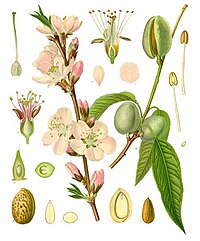
Photo from wikipedia
A large amount of almond shells are disposed of every year. The anatomical and chemical characteristics of almond shells are investigated in this paper in order to contribute to better… Click to show full abstract
A large amount of almond shells are disposed of every year. The anatomical and chemical characteristics of almond shells are investigated in this paper in order to contribute to better utilization of these shells. The micromorphology, surface elements, thermal stability, crystallization, chemical composition, and relative properties of almond shells are analyzed. Under observation by microscope and electron microscope, the diameter of almond shells is 300–500 μm for large holes, and 40–60 μm for small holes present in the shell. X-ray photoelectron spectroscopy shows the elements of almond shells include C (72.27%), O (22.88%), N (3.87%), and Si (0.87%). The main chemical constituents of cellulose, hemicellulose and lignin in almond shells account for 38.48%, 28.82% and 29.54%, respectively. The alkaline extract content of almond shells is 14.03%, and benzene alcohol extraction is 8.00%. The benzene alcohol extractives of almond shells mainly contain 17 types of organic compound, including benzene ring, ethylene, carbon three bond, and other mufti-functional groups. Thermal stability analysis shows almond shells mainly lose weight at 260 °C and 335 °C. These characteristics indicate that almond shells have the capacity to be used in composites and absorption materials.
Journal Title: Materials
Year Published: 2018
Link to full text (if available)
Share on Social Media: Sign Up to like & get
recommendations!